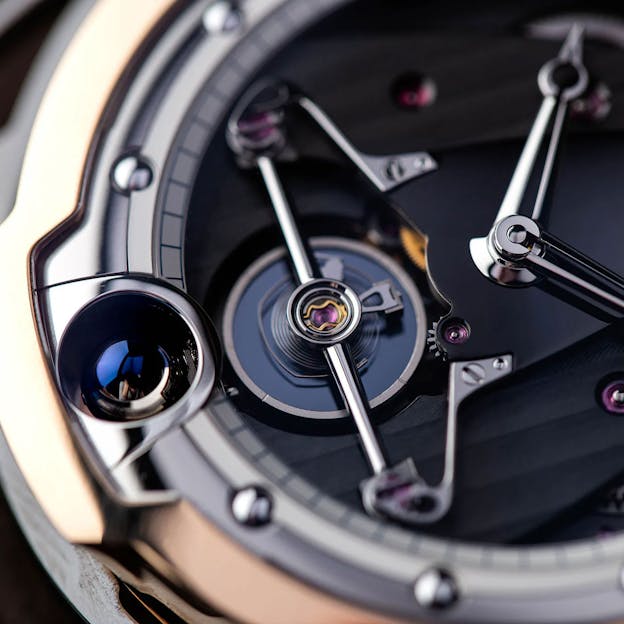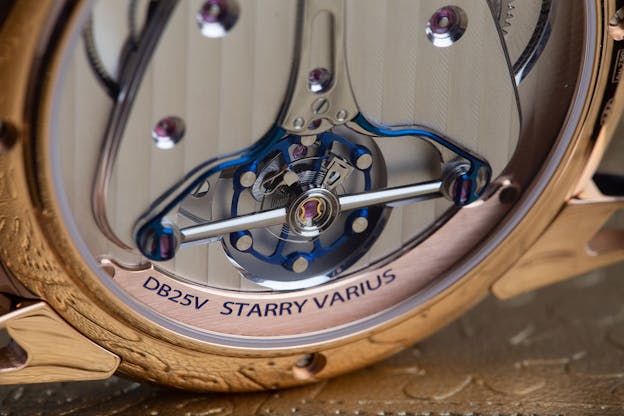De Bethune Innovations: The Science Behind The De Bethune Balances
The De Bethune balances are cool as hell to look at, but behind the sci-fi aesthetics are basic laws of nature.
De Bethune watches are easy to fall in love with just on the aesthetics alone – the company’s design language is as different from that of any other brand as you could possibly imagine or hope, and in a watch world of me-too designs and revivals of designs from the past, DB remains genuinely unique and therefore impossible to imitate. As beautiful as the watches are, however, they are also chock full of technical innovation which, if you’re dazzled by the aesthetics, might be easy to miss, but which are as essential to the company’s identity as any amount of blued (or purple-tempered) titanium. Over the years, De Bethune’s rethought just about every major core technical feature found in mechanical horology, and while we’ve done a bird’s-eye view history of these innovations, we’re going to look more in depth and in detail at each one, starting with the De Bethune balance.

Normally, balances in modern watches are more alike than not. Typically they’re made of a beryllium bronze alloy, with thin arms and an outer thicker ring. In many watches, the ring is set with weights that can be adjusted in order to fine-tune the rate of a watch – Patek uses its Gyromax system, which it began using in 1952, and Rolex uses the Microstella system; both work on the same principle.
Balances at De Bethune, however, are radical departures from conventional practice. Over the years, Denis Flageollet has created over half a dozen different types of balances, all of which have certain basic features in common. Most notably, the balances are optimized for aerodynamic efficiency, in order to reduce energy loss from aerodynamic drag, but they’re also designed to ensure that as much of the total mass of the balance is at the periphery – generally, this is done at DB by using lightweight, rigid materials like titanium or silicon, combined with outer weights made of much denser materials, such as white gold or platinum.

Now, why would you want as much of the mass of a balance to be at the rim? The reason has to do with something called moment of inertia. Moment of inertia is, to quote Britannica, ” … the opposition that the body exhibits to having its speed of rotation about an axis altered by the application of a torque (turning force).” Simply put this means that the higher the moment of inertia, the less apt a rotating body – like a watch balance – is to be disturbed by external physical (mechanical) forces and therefore, the rate stability of a balance is directly rotated to its moment of inertia – the higher the better. In this respect it’s just like linear inertia, which is the resistance of a body in motion to change in its state of motion (a body at rest tends to remain at rest; a body in motion tends to remain in motion, unless in either case it’s acted on by an external force.
The key point to bear in mind is that moment of inertia is not just a question of total mass – it’s also a function of mass distribution. Basically, the more you can concentrate as much of the mass as possible at the edge of a rotating mass, the higher the moment of inertia will be for a given total mass. This is also the reason why pendulums tend to have heavy bobs on relatively lower mass rods.

Historically, concentrating the mass of a balance at its rim was a natural outcome of the construction of watch and clock balances, which prior to the development of temperature invariant alloys like Glucydur and Nivarox (for balances and balance springs respectively) had rims made of layered steel and brass, to compensate for temperature variations in the performance of plain carbon steel balance springs; such balances would have massive screws distributed around the balance rims, in order to enable watchmakers to control temperature compensation and to fine-tune rate. The tendency in modern watchmaking has been overall towards lower mass balances running at faster frequencies but the principle of optimizing moment of inertia still applies.

Above is a type of balance introduced by De Bethune in 2004, which has titanium arms and aerodynamic platinum inertial weights. While maximizing the angular momentum is critical, it’s important to remember that the overall inertia of the balance shouldn’t be too high, otherwise it will require too much energy to drive the balance. Shifting as much mass as possible to the rim, while lowering inertia overall, is critical to achieving both energy efficiency and rate stability.

As is so often the case in fine watchmaking in general and at De Bethune in particular, the pursuit of cutting edge performance can create great visuals as well. You don’t necessarily need to know the physics of moment of inertia chapter and verse to get a kick out of the aesthetics of a De Bethune balance, but a really great watch is one that becomes more interesting, not less, the more you find out about it and with De Bethune you can have a lifetime of physical and intellectual beauty on your wrist.


